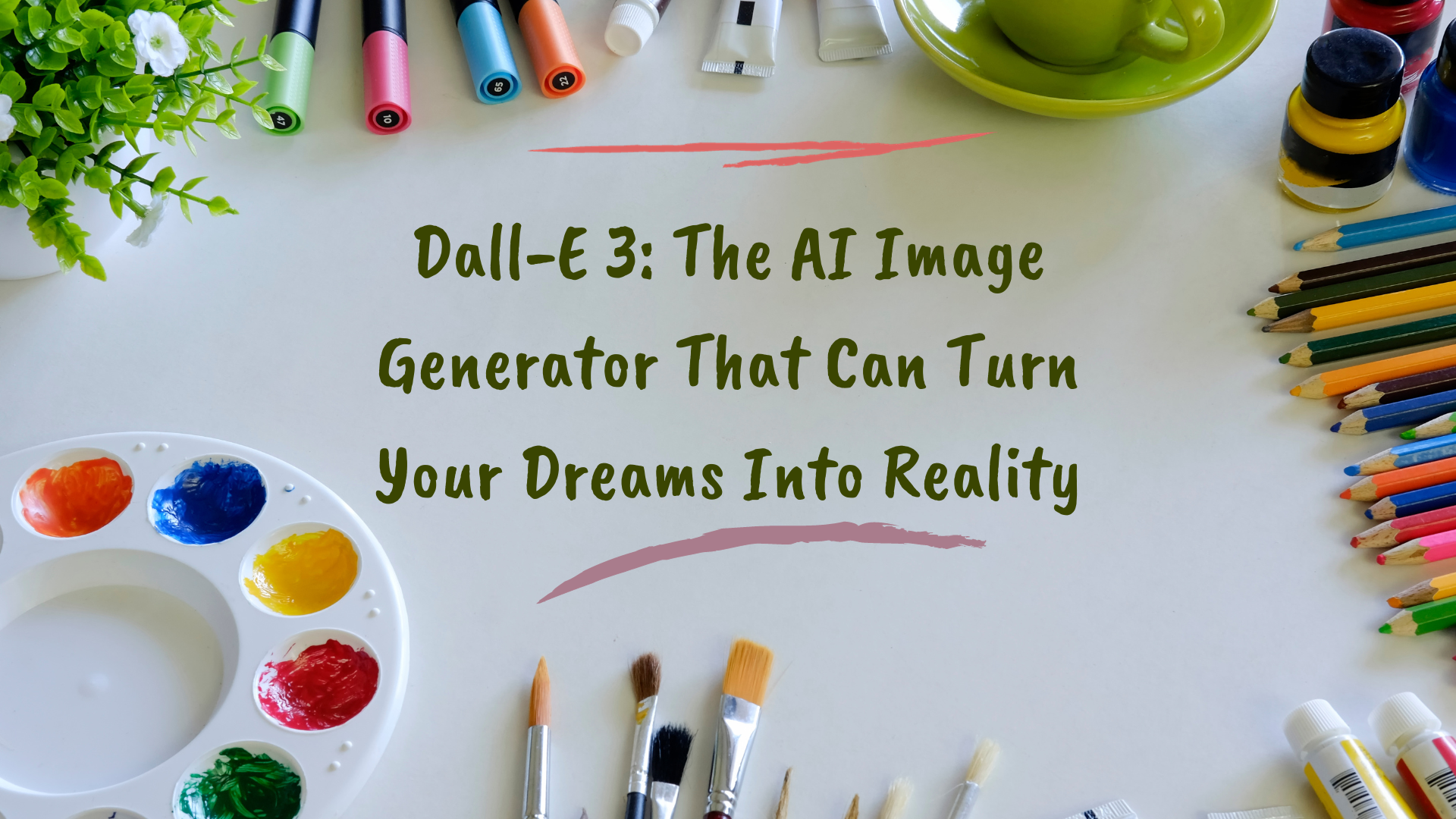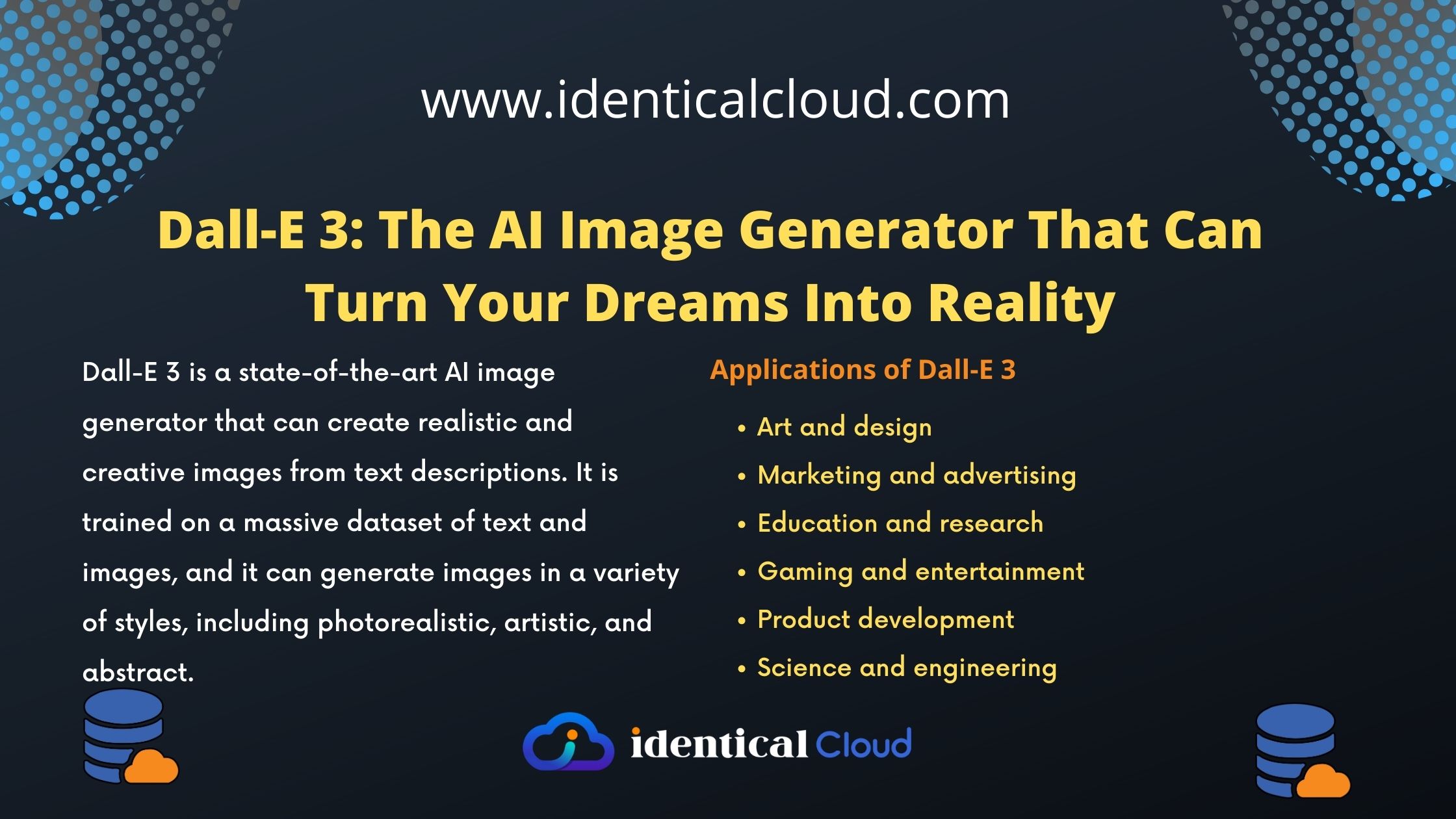
Dall-E 3: The AI Image Generator That Can Turn Your Dreams Into Reality

Dall-E 3: The AI Image Generator That Can Turn Your Dreams Into Reality
Dall-E 3 is a state-of-the-art AI image generator that can create realistic and creative images from text descriptions. It is trained on a massive dataset of text and images, and it can generate images in a variety of styles, including photorealistic, artistic, and abstract.
Dall-E 3 is still under development, but it has the potential to revolutionize the way we create and consume images. It can be used to create art, design products, market brands, and even generate educational and scientific content.
In this blog post, we will explore everything you need to know about Dall-E 3. We will discuss how it works, what it can do, and who can use it. We will also look at some of the potential applications of Dall-E 3, as well as its limitations and ethical concerns.
What is Dall-E 3?
Dall-E 3 is a text-to-image diffusion model created by OpenAI. It is the successor to the Dall-E 2 and Dall-E models, and it is able to generate more realistic and creative images from text descriptions. Dall-E 3 is trained on a massive dataset of text and images, and it can generate images in a variety of styles, including photorealistic, artistic, and abstract.
How does Dall-E 3 work?
Dall-E 3 works by first generating a low-quality image from the text description. It then uses a diffusion process to gradually refine the image until it is of high quality. The diffusion process works by adding noise to the image and then gradually removing it. As the noise is removed, the image becomes more realistic and detailed.
What can Dall-E 3 do?
Dall-E 3 can generate a wide variety of images, including:
- Photorealistic images of people, places, and objects
- Artistic images in a variety of styles
- Abstract images that are difficult to describe in words
- Images that combine different elements from different sources
Dall-E 3 can also generate images that are based on your own sketches and drawings.
Who can use Dall-E 3?
Dall-E 3 is currently in a closed beta, and access is limited to a small number of users. However, OpenAI plans to make Dall-E 3 more widely available in the future.
What are the benefits of using Dall-E 3?
Dall-E 3 has a number of benefits, including:
- It can generate high-quality images from text descriptions.
- It can generate images in a variety of styles.
- It can generate images that are based on your own sketches and drawings.
- It can be used to create art, design products, market brands, and even generate educational and scientific content.
How to use Dall-E 3
To use Dall-E 3, you first need to create an account and request access to the beta. Once you have access, you can generate images by providing a text description. You can also edit images and share them with others.
How to Use Dall-E 3: Creating an Account, Generating Images, Editing Images, and Sharing Images
Creating an account
To create an account on Dall-E 3, you first need to go to the Dall-E 3 website and click on the “Request Access” button. You will then need to fill out a form with your name, email address, and occupation. Once you have submitted the form, you will be placed on a waiting list. When access becomes available, you will receive an email with instructions on how to create your account.
Generating images
To generate an image on Dall-E 3, you first need to go to the “Generate” page and type in a text description of the image you want to create. You can also upload your own sketch or drawing to generate an image from. Once you have entered a text description or uploaded a sketch or drawing, click on the “Generate” button. Dall-E 3 will then generate a number of images based on your request. You can select the image you like best and click on the “Download” button to save it to your computer.
Editing images
To edit an image on Dall-E 3, you first need to go to the “Edit” page and select the image you want to edit. You can then use the editing tools to crop, resize, and adjust the brightness, contrast, and saturation of the image. You can also add text and shapes to the image. Once you have finished editing the image, click on the “Save” button to save your changes.
Sharing images
To share an image on Dall-E 3, you first need to go to the “Share” page and select the image you want to share. You can then share the image via email, social media, or a link.
Applications of Dall-E 3
Dall-E 3 can be used for a variety of applications:
- Art and design: Dall-E 3 can be used to create new and innovative works of art and design. For example, Dall-E 3 can be used to generate concept art for video games or movies, or to create new product designs.
- Marketing and advertising: Dall-E 3 can be used to create engaging and eye-catching marketing and advertising materials. For example, Dall-E 3 can be used to generate product images for websites or social media, or to create new advertising campaigns.
- Education and research: Dall-E 3 can be used to create educational and research materials that are more engaging and informative. For example, Dall-E 3 can be used to generate diagrams and illustrations for textbooks or scientific papers.
- Gaming and entertainment: Dall-E 3 can be used to create new and innovative video games and movies. For example, Dall-E 3 can be used to generate game environments or movie characters.
- Product development: Dall-E 3 can be used to develop new products and services. For example, Dall-E 3 can be used to generate concepts for new products or to create prototypes.
- Science and engineering: Dall-E 3 can be used to create new scientific and engineering discoveries. For example, Dall-E 3 can be used to generate images of new molecules or to create designs for new machines.
Applications and Limitations of Dall-E 3
Applications of Dall-E 3
Dall-E 3 can be used for a variety of applications, including:
- Art and design: Dall-E 3 can be used to create new and innovative works of art and design. For example, Dall-E 3 can be used to generate concept art for video games or movies, or to create new product designs.
- Marketing and advertising: Dall-E 3 can be used to create engaging and eye-catching marketing and advertising materials. For example, Dall-E 3 can be used to generate product images for websites or social media, or to create new advertising campaigns.
- Education and research: Dall-E 3 can be used to create educational and research materials that are more engaging and informative. For example, Dall-E 3 can be used to generate diagrams and illustrations for textbooks or scientific papers.
- Gaming and entertainment: Dall-E 3 can be used to create new and innovative video games and movies. For example, Dall-E 3 can be used to generate game environments or movie characters.
- Product development: Dall-E 3 can be used to develop new products and services. For example, Dall-E 3 can be used to generate concepts for new products or to create prototypes.
- Science and engineering: Dall-E 3 can be used to create new scientific and engineering discoveries. For example, Dall-E 3 can be used to generate images of new molecules or to create designs for new machines.
Limitations of Dall-E 3
Dall-E 3 is still under development, and it has a number of limitations, including:
- Cost: Dall-E 3 is currently very expensive to use.
- Availability: Dall-E 3 is currently only available to a small number of users.
- Bias: Dall-E 3 is trained on a massive dataset of text and images, and it can reflect the biases that are present in this dataset.
- Ethical concerns: There are a number of ethical concerns surrounding the use of Dall-E 3, such as the potential for Dall-E 3 to be used to create deepfakes or to generate harmful content.
Dall-E 3 Ethical Considerations
As a powerful tool with the potential to revolutionize a variety of industries and applications, it is important to consider the ethical implications of Dall-E 3. Some of the key ethical considerations include:
- Bias: Dall-E 3 is trained on a massive dataset of text and images, and it can reflect the biases that are present in this dataset. It is important to be aware of these biases and to take steps to mitigate them, such as using a diverse dataset to train Dall-E 3 and carefully reviewing the results before using them.
- Copyright and intellectual property: Dall-E 3 can be used to create images that are similar to existing works of art or design. It is important to be aware of copyright and intellectual property laws and to avoid using Dall-E 3 to create images that infringe on the rights of others.
- Misinformation and disinformation: Dall-E 3 can be used to create images that are realistic but false. It is important to be aware of the potential for Dall-E 3 to be used to create misinformation and disinformation, and to take steps to verify the authenticity of images before sharing them.
Cost, Availability, Bias, Ethical Concerns, and Future of Dall-E 3
Cost: Dall-E 3 is currently very expensive to use. The cost of using Dall-E 3 varies depending on the number of images you generate and the resolution of the images. However, the cost per image can be very high, especially for high-resolution images.
Availability: Dall-E 3 is currently only available to a small number of users. OpenAI is still in the process of developing Dall-E 3 and making it more widely available.
Bias: Dall-E 3 is trained on a massive dataset of text and images, and it can reflect the biases that are present in this dataset. For example, if Dall-E 3 is trained on a dataset that is mostly of white people, it is more likely to generate images of white people. It is important to be aware of these biases and to take steps to mitigate them, such as using a diverse dataset to train Dall-E 3 and carefully reviewing the results before using them.
Ethical concerns: There are a number of ethical concerns surrounding the use of Dall-E 3, such as the potential for Dall-E 3 to be used to create deepfakes or to generate harmful content. For example, Dall-E 3 could be used to create fake images of politicians or celebrities that could be used to spread misinformation or disinformation. It is important to be aware of these ethical concerns and to take steps to mitigate them, such as developing ethical guidelines for the use of Dall-E 3.
Future of Dall-E 3: Dall-E 3 is a new technology with a lot of potential. As Dall-E 3 continues to develop and become more widely available, it is likely to have a significant impact on a variety of industries and applications. For example, Dall-E 3 could be used to create new forms of art and entertainment, or to develop new products and services.
What are the next steps for Dall-E 3?
OpenAI has not announced any specific next steps for Dall-E 3:
- Making Dall-E 3 more accessible: Dall-E 3 is currently only available to a small number of users. OpenAI could make Dall-E 3 more accessible by releasing it to a wider audience or by developing a public API.
- Reducing the cost of using Dall-E 3: Dall-E 3 is currently very expensive to use. OpenAI could reduce the cost of using Dall-E 3 by developing new algorithms that are more efficient or by finding new ways to monetize Dall-E 3.
- Improving the quality and realism of Dall-E 3 images: Dall-E 3 is still under development, and its images can sometimes be unrealistic or inaccurate. OpenAI could improve the quality and realism of Dall-E 3 images by continuing to train Dall-E 3 on a larger and more diverse dataset of text and images.
- Addressing the ethical concerns of Dall-E 3: There are a number of ethical concerns surrounding the use of Dall-E 3, such as the potential for Dall-E 3 to be used to create deepfakes or to generate harmful content. OpenAI could address these ethical concerns by developing ethical guidelines for the use of Dall-E 3 or by developing tools to help users identify and flag harmful content.
How will Dall-E 3 impact the world?
Dall-E 3 is a powerful new AI image generator that has the potential to impact the world in many ways.
Art and design: Dall-E 3 can be used to create new and innovative forms of art and design. For example, Dall-E 3 can be used to generate concept art for video games or movies, or to create new product designs.
Marketing and advertising: Dall-E 3 can be used to create engaging and eye-catching marketing and advertising materials. For example, Dall-E 3 can be used to generate product images for websites or social media, or to create new advertising campaigns.
Education and research: Dall-E 3 can be used to create educational and research materials that are more engaging and informative. For example, Dall-E 3 can be used to generate diagrams and illustrations for textbooks or scientific papers.
Gaming and entertainment: Dall-E 3 can be used to create new and innovative video games and movies. For example, Dall-E 3 can be used to generate game environments or movie characters.
Product development: Dall-E 3 can be used to develop new products and services. For example, Dall-E 3 can be used to generate concepts for new products or to create prototypes.
Science and engineering: Dall-E 3 can be used to create new scientific and engineering discoveries. For example, Dall-E 3 can be used to generate images of new molecules or to create designs for new machines.
Summary of key points:
- Dall-E 3 is a powerful new AI image generator that can create realistic and creative images from text descriptions.
- It is still under development, but it has the potential to revolutionize a variety of industries and applications.
- Dall-E 3 can be used to create art and design, marketing and advertising materials, educational and research materials, video games and movies, and new products and services.
- However, it is important to be aware of the limitations and ethical concerns of Dall-E 3, such as its cost, availability, bias, and the potential for misuse.
Dall-E 3 is a powerful new technology with the potential to make a positive impact on the world. It is important to use Dall-E 3 responsibly and to take steps to mitigate the potential risks. However, there is no doubt that Dall-E 3 has the potential to change the way we create and consume images.
Dall-E 3 is a powerful new tool that can be used to create and consume images in new and innovative ways. It is still under development, but it has the potential to revolutionize a variety of industries and applications.
As Dall-E 3 continues to develop and become more accessible, it is important to be aware of its potential limitations and ethical concerns. However, Dall-E 3 also has the potential to make a positive impact on the world, and it is exciting to think about what the future holds for this AI image generator.
We hope that this blog post has given you a better understanding of Dall-E 3 and its potential impact on the world. If you have any questions or comments, please feel free to leave them below.
FAQ’s
What is Dall-E 3?
Dall-E 3 is a powerful new AI image generator that can create realistic and creative images from text descriptions. It is still under development, but it has the potential to revolutionize a variety of industries and applications.
How does Dall-E 3 work?
Dall-E 3 works by first generating a low-quality image from the text description. It then uses a diffusion process to gradually refine the image until it is of high quality. The diffusion process works by adding noise to the image and then gradually removing it. As the noise is removed, the image becomes more realistic and detailed.
What can Dall-E 3 do?
Dall-E 3 can generate a wide variety of images:
– Photorealistic images of people, places, and objects
– Artistic images in a variety of styles
– Abstract images that are difficult to describe in words
– Images that combine different elements from different sources
Who can use Dall-E 3?
Dall-E 3 is currently in a closed beta, and access is limited to a small number of users. However, OpenAI plans to make Dall-E 3 more widely available in the future.
How to use Dall-E 3
To use Dall-E 3, you first need to create an account and request access to the beta. Once you have access, you can generate images by providing a text description. You can also edit images and share them with others.








